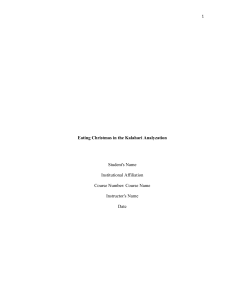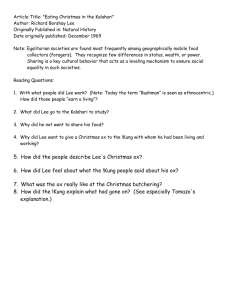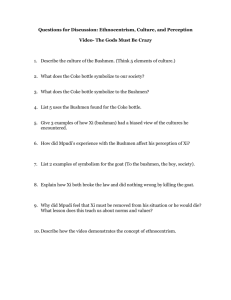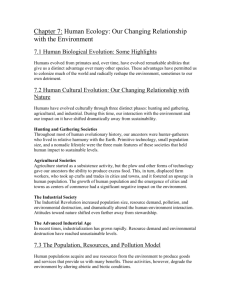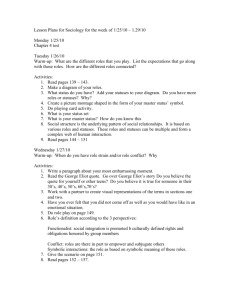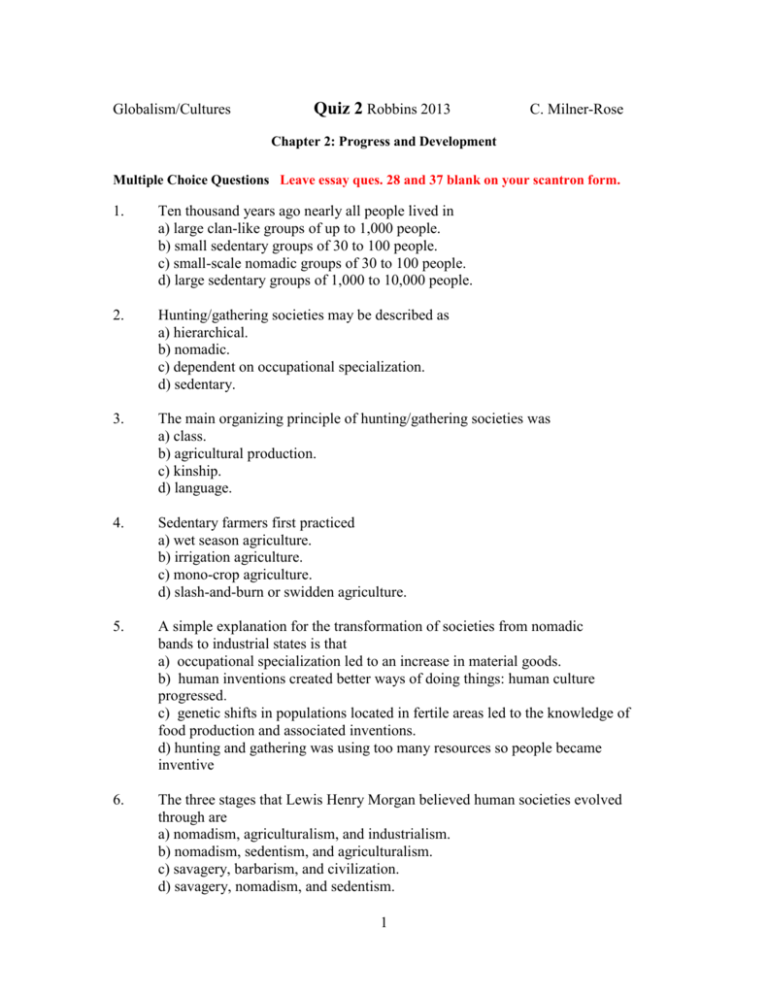
Globalism/Cultures
Quiz 2 Robbins 2013
C. Milner-Rose
Chapter 2: Progress and Development
Multiple Choice Questions Leave essay ques. 28 and 37 blank on your scantron form.
1.
Ten thousand years ago nearly all people lived in
a) large clan-like groups of up to 1,000 people.
b) small sedentary groups of 30 to 100 people.
c) small-scale nomadic groups of 30 to 100 people.
d) large sedentary groups of 1,000 to 10,000 people.
2.
Hunting/gathering societies may be described as
a) hierarchical.
b) nomadic.
c) dependent on occupational specialization.
d) sedentary.
3.
The main organizing principle of hunting/gathering societies was
a) class.
b) agricultural production.
c) kinship.
d) language.
4.
Sedentary farmers first practiced
a) wet season agriculture.
b) irrigation agriculture.
c) mono-crop agriculture.
d) slash-and-burn or swidden agriculture.
5.
A simple explanation for the transformation of societies from nomadic
bands to industrial states is that
a) occupational specialization led to an increase in material goods.
b) human inventions created better ways of doing things: human culture
progressed.
c) genetic shifts in populations located in fertile areas led to the knowledge of
food production and associated inventions.
d) hunting and gathering was using too many resources so people became
inventive
6.
The three stages that Lewis Henry Morgan believed human societies evolved
through are
a) nomadism, agriculturalism, and industrialism.
b) nomadism, sedentism, and agriculturalism.
c) savagery, barbarism, and civilization.
d) savagery, nomadism, and sedentism.
1
7.
The Ju/Wasi's major food source at the time of Lee's study was
a) grains.
b) elephant meat.
c) mongongo nuts.
d) fish.
8.
Cohen argues that the main force that drove societies to adopt agriculture was
a) population growth.
b) conflict with other groups.
c) occupational specialization.
d) nomadism.
9.
The Hadza spend about how many hours a day obtaining food?
a) 12 hours
b) 2 hours
c) 7 hours
d) 18 hours
10.
Cultural evolutionist Leslie White asserts that cultural development
a) results from increasing population.
b) is solely tied to environmental changes.
c) results from contact with other groups (diffusionist theory).
d) varies directly with the efficiency of the tools employed.
11.
The increase in the number of people relative to the available land creates two
problems:
a) more people than available land to feed them and need for greater societal
organization.
b) increase in infectious diseases and need for less social organization.
c) need for political control of resources and a struggle to decrease births.
d) need for non-kin based organization and better crop development.
12.
As a society increases in numbers & complexity, incidences of infectious disease
a) decrease.
b) increase.
c) remain the same.
d) disappear.
13.
The single most important determinant of a country’s ability to protect its citizens
from disease is
a) state-supported health care.
b) the building of clinics and hospitals.
c) the degree of economic equality.
d) funding medical research.
2
14.
Which type of population is more likely to increase the spread of an infectious
disease?
a) A small and scattered population
b) A large, dense, permanent settlement.
c) A technologically advanced population
d) An urban population
15.
For the Chewa of Malawi, illness caused by sorcery occurs
a) when people have violated the will of the gods and created social tension.
b) because ancestral ghosts have not been appeased through observance of ritual
and their earthly agents (sorcerers) punish offenders.
c) when magic is practiced over petty jealousies in the village.
d) when there is a conflict over judicial rights and claims or when someone fails
to observe some social norm.
16.
When societies abandon hunting/gathering, they usually become
a) herders.
b) swidden agriculturalists.
c) criminals.
d) students.
17.
Approximately what percentage of potatoes grown in the United States is
processed into products like chips and instant mashed potatoes?
a) 10 percent
b) 30 percent
c) 50 percent
d) 75 percent
18.
Which of the following societies was exterminated as a result of contact with
Europeans?
a) Inuit
b) Ju/Wasi
c) Ona
d) Cherokee
19.
It is estimated that after European contact in the New World, ____ of the
indigenous populations died off.
a) 30%
b) 70%
c) 25%
d) 90%
20.
The factory model of agriculture produces
a) a mixed variety of crops with annual field rotation.
b) food resources to sustain the world’s growing population for the 21st century.
c) a single product (such as corn, soy, beef, or pork) in as short a time as possible.
d) enough surplus to sustain the U.S. food supply for two years.
21.
Ronald Nigh’s idea of an agroecological approach to food production is
a) it creates a polyculture—the production of multiple crops and animals—rather
than a monoculture—the growth or production of a single crop or animal.
b) it provides many more jobs in developing countries.
3
c) it sustains kin-based systems of production and curbing migration to cities.
d) a novel approach to better produce and distribute organic products to
America’s fast growing demand for the food.
True/False Questions
22. The Hadza of Tanzania often are malnourished due to their lifestyle in the dry
savanna.
23. Americans expend less than one calorie of energy to produce a single calorie of
food.
24. Life expectancy more than doubled in the 20th century.
25. American farmers using Native American land and African labor to produce cotton
for the English and American textile industries created much of the wealth of the young
American republic.
26. Societies chose to change from hunter/gatherer lifestyles to agricultural lifestyles
because agriculture is less time-consuming.
27. The agroecological approach incorporates indigenous practices to produce food but
preserve the environment with contemporary agricultural research.
Essay Questions - worth 3 pts. Pick one.
28a. How do Americans generally view the relationships between technology, progress,
and problem solving? [p. 45] Is American potato production actually less efficient
and more costly in terms of energy than traditional New Guinea potato production?
[pp. 51-52] Compare the amount of human and non-human energy that goes into
agricultural production in New Guinea as opposed to the United States. Which system
is more efficient, and why? [pp. 68-70]
28b. What were some of the changes introduced by colonial powers in Brazil that
decreased people's access to food? [p. 61] Why do some people in Brazil still not get
enough to eat. [p. 61-62]
28c. Describe some of the ways that human behavior influences the incidence of disease.
[p. 63] Complex societies create conditions conducive to the spread of infectious
disease and the survival of microorganisms. Name at least four of these conditions
that are created. [p. 64] How might we explain that hunter/gatherers of 10,000 years
ago experienced infectious diseases to a lesser degree than today? [pp. 69-70]
4
28d. Is the concept of progress—the idea that human history is the story of a steady
advance from a life dependent on the whims of nature to a life of control and domination
over natural forces—a fabrication of contemporary societies based on ethnocentric
notions of technological superiority? [p. 41]
28e. Soul loss, spirit possession, sorcery, and witchcraft are all expressions of the
interpersonal theory of disease. Explain how these traditional theories of illnesses are
expressions of interpersonal theories of disease and how the patients could have been
cured through traditional healers or witches. [pp. 65-67]
Essay Questions – worth 2 pts. Pick one.
28f. How can the concept of progress be defined, and why is this notion of progress
questionable? [p. 41]
28g. What four things have to happen for humans to die due to infectious disease? [pp.
63-]
Annual Editions 12/13 Eating Christmas in the Kalahari
KEY TERMS AND TOPICS
Hunting And Gathering Subsistence Economy -- an economy that
does not store food but hunts or gathers when it is necessary.
Christmas Ox -- a Christmas custom in the Kalahari Desert
wherein the Tswana headman slaughters an ox for his Bushmen
neighbors as an annual goodwill gesture.
Social Anthropologist -- an anthropologist who studies aspects
of the social structure of a tribe, in this case the economy of
the !Kung Bushmen.
29. As explained in "Eating Christmas in the Kalahari," Richard Borshay Lee found that
a. an outsider should not visit the Bushmen without bringing a gift.
b. Bushmen do not welcome visitors at holidays.
c. it is considered incorrect to insult guests within the Bushmen society.
d. the response of people to a gift can be instructive about their culture.
30. According to "Eating Christmas in the Kalahari," the !Kung Bushmen's interpretation
of the Christmas story is that it
a. honors the birth of Christ.
b. praises the birth of white man's god-chief.
c. represents the night of the shooting star.
d. means that it is gift-giving time.
5
31. In "Eating Christmas in the Kalahari," author Richard Borshay Lee claims that it is a
general custom among the !Kung Bushmen to insult the animal that a man has tracked
down and killed and that he intends to share with the rest of the tribe because they
a. are amused by malicious jokes.
b. are genuinely dissatisfied and hope he will do better next time.
c. want to enforce general humility and prevent that man from boasting and thinking
of the tribe as his servants or inferiors.
d. always have plenty of food on hand and rarely require any additional contribution.
32. During most of his stay with the Bushmen, Lee gave generously of his food and drink
to stay on good terms with them. (T/F)
33. In "Eating Christmas in the Kalahari," it is reported that the !Kung Bushmen only
insult boastful outsiders, never members of their own tribe. (T/F)
34. Richard Lee's original intention of slaughtering an ox for the Bushmen was to
a. say "thank you" for their cooperation.
b. get them to allow him to do his ethnographic study.
a. show his superiority over them.
b. do all of the above
35. Even before Richard Lee decided to slaughter a Christmas ox for the
Bushmen
a. they already had some knowledge about Christmas.
b. slaughtering an ox for them by the neighboring pastoralists had already become an
annual event.
c. there had already been established a December congregation at the cattle posts for
trading, marriage brokering and several days of trance-dance feasting.
d. all of the above.
36. As explained in "Eating Christmas in the Kalahari," among the characteristics of the
traditional !Kung Christmas celebration are traditional Christian observances. (T/F)
Essay Options – worth 2 pts.
37a. As discussed in "Eating Christmas in the Kalahari," why did Lee decide to give the
!Kung Bushmen "the largest, meatiest ox that money could buy?" Did his evaluation of
his own motivations change? Did Lee think his reasons were purely generous before he
understood their jokes and insults? What does he think about his motivations afterward?
37b. In "Eating Christmas in the Kalahari," Lee describes how he used tobacco to enforce
cooperation and writes, "I was a perfect target for the charge of arrogance." What do you
think about the methods he uses? In your opinion, is this a fair self-evaluation? Explain.
6
Annual Editions 12/13 How Cooking Frees Men
KEY TERMS AND TOPICS
Sexual Division of Labor -- the idea that men and women make different and
complementary contributions to the household economy.
Ekwa -- a starchy tuber that is a staple for the Hadza tribe of northern Tanzania.
Karosses -- cloaks made of animal skins, worn by women of the Hadza tribe.
38. As detailed in “How Cooking Frees Men,” the main reason that it took
so long for people to obtain the necessary calories for survival in pre-cooking humans
was the amount of time it took
a. to hunt large animals.
b. to gather enough vegetable and fruit matter for a day’s caloric needs.
c. for people to chew a raw diet.
d. to gather foods not only for the day’s needs but to store for the winters.
39. Which of the following is true regarding the sexual division of labor in hunting and
gathering societies?
a. Women typically produce most of the calories.
b. The value of the men’s contribution is always more critical in maintaining health
and survival.
c. Reliance upon sharing seems to have required a cooperative temperament and
exceptional intelligence.
d. The relative importance of foods obtained by women and men does not change at
different times of the year.
40. According to “How Cooking Frees Men,” even though gender-specific roles may
vary from one society to another, the gendered division of labor is a human universal.
(T/F)
41. Although the specific food types varied from place to place, in hunting and gathering
societies, men always tended to provide the staples. (T/F)
42. The sexual division of labor in hunting and gathering societies was made possible by
the cooking of food. (T/F)
43. As described in “How Cooking Frees Men,” the Hadza are modern-day people in
most respects, but they are also one of the few remaining peoples who
a. continue to eat an entirely raw diet.
b. survive almost entirely by eating large animals that they hunt.
c. reverse traditional roles, so that the men do most of the
gathering and the women do most of the hunting.
d. obtain the majority of their food by foraging in a woodland.
7
44. As mentioned in “How Cooking Frees Men,” sociologist Emile Durkheim
thought that the most important result of the division of labor by sex was
a. the formation of the nuclear family unit.
b. promoting moral standards.
c. an increase in nutrition for both men and women.
d. to confuse biological imperatives with social constructs.
45. Which of the following is true concerning the sexual division of labor in human
societies?
a. Cooking made it possible.
b. It is a human universal.
c. It first appeared among hunter-gatherers.
d. All of the above are true.
46. Which of the following is true of the food obtained by men in hunting and gathering
societies? It
a. normally required laborious processing.
b. could be found easily and predictably.
c. could not be considered a staple the way the women’s gathered food could.
d. was never cooked.
47. The most distinctive difference between humans and other primates is that, in
primates
a. there are no sex differences in food procurement and preferences with regard to
consumption.
b. there are no family groupings.
c. males and females do not spend much time together.
d. adults never give food to each other.
48. As explained in “How Cooking Frees Men,” how does the sexual division of labor in
human hunter-gatherers differentiate them from non-human primates?
a. among humans, males and females spend their days seeking different
kinds of foods, and the foods they obtain are eaten by both sexes.
b. in humans, food is shared among adults, especially between mates, not just between
mothers and children.
c. among humans, mothers share food with their offspring and chimps never do.
d. all of the above
e. a and b only.
49. As put forth in “How Cooking Frees Men,” physical anthropologist Sherwood
Washburn reasoned, when males hunt and females gather, the results are shared and
given to the young. The habitual sharing between a male, a female, and their offspring
becomes the basis for the evolution of the human family, ie. the human family is the
result of cooperation and reciprocity between the efforts of males and females. (T/F)
8

